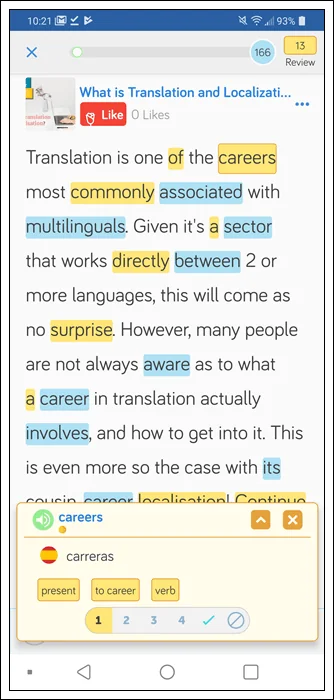3 Tips to Help You Learn American English Pronunciation
Are you a big fan of music by American singers? Do you watch a lot of Hollywood movies? If so, the best ways to learn American English are right in front of you. You just have to tune it up a little bit.
In this post, we’ll take a look at some of the most effective ways of practicing, understanding, and mastering the art of American English pronunciation on your way to becoming a native-like English speaker.
Spoiler alert: This article does not cover grammar rules, vocabulary preferences or rules of thumb in everyday conversations that native speakers of the American English dialect use. Today, it’s all about pronunciation.
What Is Important to Know About American English Pronunciation?
Sooner or later, most English learners are faced with the dilemma of choosing between American English vs. British English pronunciation in their everyday speech.
If you’re in the American English camp, you’ll notice how most of the pronunciation and sounds are softer when compared to their sharper and more distinct British counterparts.
As an example, in American English, the word “matter” sounds like “mad-er”. In British English, it sounds more like “mat-uh”. The difference between the pronunciations of the r sound in these two words is also very noticeable.
We can see that the consonants are more precisely and sharply pronounced in the British dialect while being softer and more toned down in American English. This is usually the case with most words across the two dialects.

These sorts of differences are very distinct and help us paint a better picture of exactly how American English sounds when spoken by the native speakers and how you – the language learner – can learn, practice, and master it.
The following are some of the key strategies and tricks you can use when trying to learn American English pronunciation.
Master Vowel Intonation
In the examples above, we looked at how consonants behave in American English pronunciation. Let’s focus on vowels for a moment.
If you pay close attention to how speakers of the American English dialect actually pronounce words that contain vowels, you will find that the vowel sounds are always a mixture of two sounds. Actually, it’s a sound in-between those two sounds. Actually, never mind… let’s take a look.
The most noticeable examples are always with the long vowel sound a.
Notice how the a vowel sound in the words “bat” and “back” is actually a mixture of a and e. If these were pure a and e sounds, the words you’d pronounce would be but and bet or buck and beck, respectively (which they obviously aren’t).
The same goes for the short vowel u in the word put. It is not a clear u nor the neutral schwa sound but (again) a sound in-between those two.
In sum, we can say that most vowel sounds in American English are just slightly more… in-between. This is why you should pay such close attention to them in your speech if you want to learn American English pronunciation the proper way.

Pick Up Other Verbal Cues
When it comes to other verbal cues, there are plenty of things you can pick up to sound like a native. Most native English speakers love to use filler words such as “um…”, “so…”, “like…”, etc. However, they use these very sparingly.
Their purpose is to fill any type of void (those awkward pauses you make when you’re thinking of what to say next) during speech. You can almost say that they don’t produce these sounds on purpose. It’s a natural part of their everyday speech.
In your case, you can use these breaks to re-focus and concentrate on every single sound you are about to pronounce, especially if a more complicated word is coming up.
(Not So) Fun Fact: If you were to produce these filler sounds on purpose, rest assured you’d be annoying the brains out of everyone who can hear you. Don’t know what we mean? Here’s a quick example:
So, um remember the um teacher who um taught us English 5 years ago and um he was like so like um detailed in all of his um lessons?
Don’t be this person, okay? Thank you.
Another very important verbal cue to focus on that can help you tremendously when learning American English pronunciation is the position of the lips, tongue, and teeth during the pronunciation of specific sounds.
The most important sounds to focus on here would be the th and w sounds, as the mix-up of their close equivalents could really put you in a tight spot.
Simply put, th is not t or d. On the other hand, w is not v. Here are some examples to demonstrate these differences:
think vs. tink, this vs. diss, path vs. pat, loathe vs. load, bath vs. bat
wave (should be enough of an example to help you distinguish w and v – two very different sounds)

Listen, Imitate & Record
Now the best thing to do is to listen and practice. In fact, aim to repeat exactly what you hear when you listen to native speakers (at all times). Try to imitate American English sound to the point. Yes, that’s right – try to literally imitate what you hear.
As to why, this technique can help you develop healthy speaking habits, especially when it comes to the pronunciation of certain words and the positioning of your mouth, tongue, and teeth during speech.
If you want to learn American English pronunciation the right way, trust us – there will be a whole lot of tongue-twisting and word mix-ups until you get it right.
This is why tracking your progress when practicing is essential.
The best way to do this is to record videos of yourself and play them back (over and over again, if needed) to gain insights into how well you can imitate that coveted native speaker sound and how you’re progressing over time.
This is one of those simple things that you can do in a mirror while singing along to your favourite song or trying to repeat what your favourite character just said in that cool TV show. Either way, practice (and tracking your progress) makes perfect.
Learn American English Vocabulary & Pronunciation with LingQ!
American English pronunciation is a bit “specific”, to say the least. However, this is what makes it so distinct and somewhat easy to learn for non-native speakers.
To simplify that journey even more, the LingQ mobile app allows you to use any content you love to practice your English. Import any new vocabulary, online articles or videos into your English lessons and practice on the go.

Try it out now! Download the LingQ mobile app for Android or iOS. Happy learning, everyone!
We’re often asked: is English hard to learn? Well, not if you enjoy the learning process! That’s why there’s LingQ, which allows you to learn English from content you love! This means you can catch up on your favourite English Netflix series or podcasts while furthering your language skills. Check out LingQ today to get started!
***
Jasmin Alić is an award-winning EFL/ESL teacher and writing aficionado from Bosnia and Herzegovina with years of experience in multicultural learning environments.


